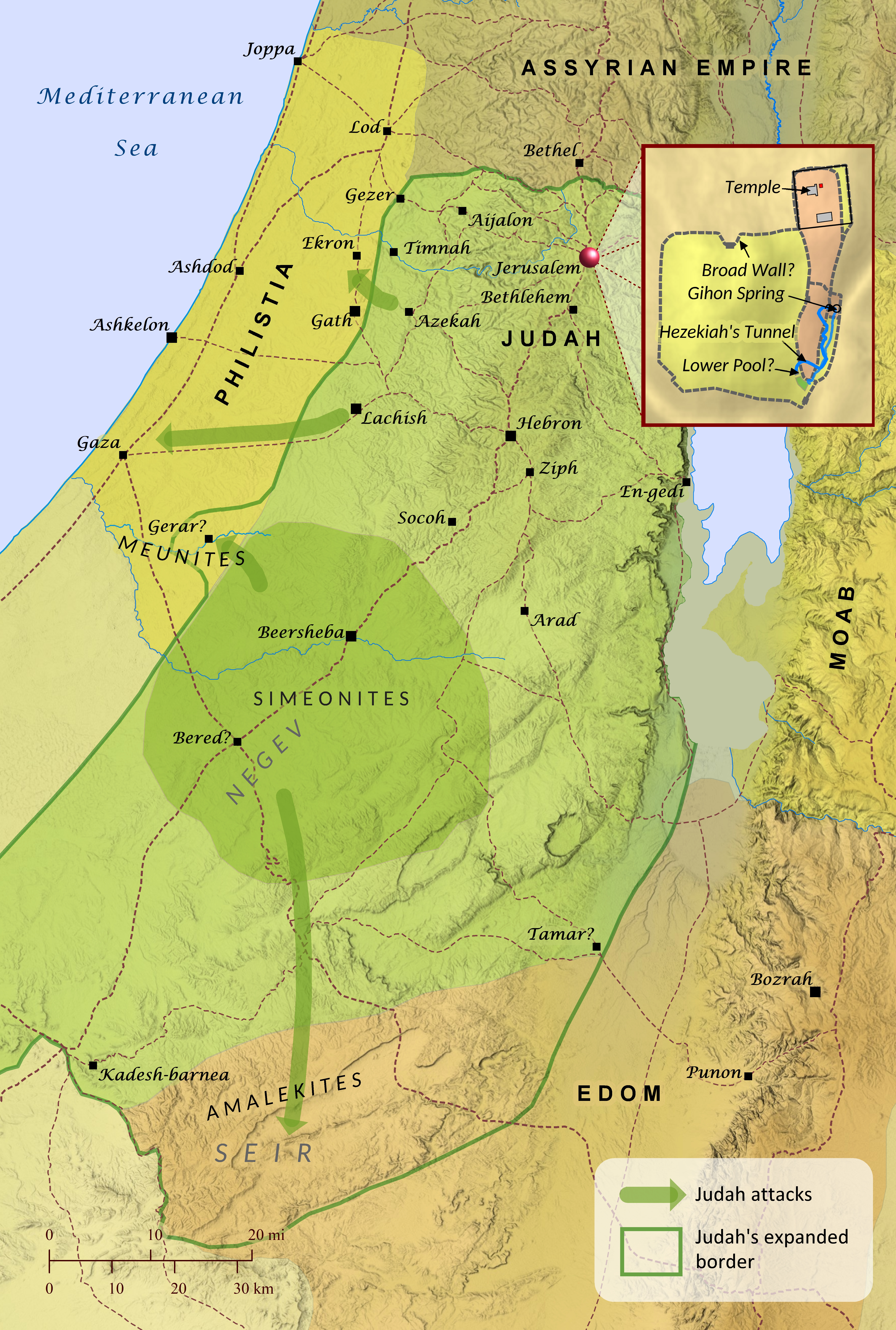
Hezekiah Strengthens Judah
2 Kings 18:1-12; 1 Chronicles 4:39-43; 2 Chronicles 29-31
Throughout his reign, Hezekiah strengthened Judah by restoring proper worship of the Lord and preparing the nation for revolt against Assyria. Though the Bible does not clearly say, both of these aspects of Hezekiah’s reign may have been borne out of a desire to undo the detrimental choices of his father, Ahaz, who had promoted idolatry through Judah (2 Chronicles 28:1-4) and made Judah a vassal to the king of Assyria in exchange for help against Israel and Aram (2 Kings 16-17; 2 Chronicles 28; Isaiah 7-8; see also “The Final Days of the Northern Kingdom of Israel” map). Later, when Hezekiah was a teenager, he witnessed Assyria’s grueling three year siege to capture Samaria (2 Kings 17:1-6; 18:9-12), perhaps cementing his resolve to throw off Judah’s yolk of servitude to Assyria (2 Kings 18:7). Whatever the reasons for his actions as king, Hezekiah spent considerable resources promoting the worship of the Lord and preparing for the inevitable Assyrian attack that would follow Judah’s refusal to submit to Assyria any longer. Hezekiah began by directing the priests and Levites to consecrate themselves and restore ritual purity to the Temple and all its furnishings (2 Chronicles 29). He sent word throughout all Israel and Judah to come and celebrate Passover together once again in Jerusalem (2 Chronicles 30). Though only a few from Israel accepted Hezekiah’s invitation, the Passover was a time of great celebration and worship for all who did come from Israel and Judah. After this, the worshipers went throughout Israel and Judah and destroyed the pagan worship centers (2 Kings 18:4; 2 Chronicles 31:1). Hezekiah also conducted a series of actions to strengthen Judah against the coming Assyrian attack. On the west he attacked the Philistines as far as Gaza (2 Kings 18:8). Part of this effort may have included a Simeonite attack on some Meunites in the valley of Gerar (as in the Septuagint; the Hebrew reading Gedor is likely due to a misreading of the letter r as the similarly shaped letter d), which is recounted in 1 Chronicles 4:39-41. Elsewhere in Scripture the Meunites appear to have lived in the region of Seir (2 Chronicles 20), south of Judah, but a remnant of them may have fled toward Gerar during Uzziah’s time when he attacked them and likely took some of them captive to serve at the Temple of the Lord in Jerusalem (Ezra 2:50; Nehemiah 7:52; also see “Resurgence of Israel and Judah” map). Other Simeonites attacked a remnant of Amalekites living in Seir, thus providing increased protection on Judah’s southern border (1 Chronicles 4:39-43). Hezekiah also fortified Jerusalem and redirected various sources of water away from enemies who might lay siege to the city (2 Chronicles 32:1-8). As part of these preparations Hezekiah commissioned the hewing of a tunnel that channeled water from the Gihon spring (probably also called the “waters of Shiloah” in Isaiah 8:6) away from the eastern side of the city and deposited it in the Lower Pool (also called the Pool of Siloam) further inside the city walls. Hezekiah also repaired portions of the wall that were broken down and built a second wall outside it, likely in the Kidron Valley. He also produced many weapons and shields. The writer of Chronicles appears to portray these preparations as being in keeping with Hezekiah’s other acts of faithfulness and righteousness. Some scholars, however, suspect that Isaiah 22:1-14 may reflect another perspective regarding Hezekiah’s preparations, though it is not certain that this passage refers to Hezekiah’s efforts.